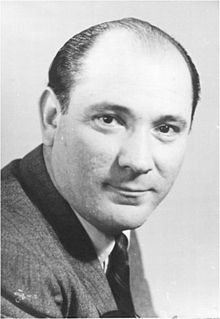Teohari Georgescu
| Teohari Georgescu | |
|---|---|
 |
|
| Interior Minister of Romania | |
|
In office March 6, 1945 – May 28, 1952 |
|
| Preceded by | Nicolae Rădescu |
| Succeeded by | Alexandru Drăghici |
| Personal details | |
| Born |
January 31, 1908 Bacău |
| Died | December 31, 1976 (aged 68) Bucharest |
| Nationality | Romanian |
| Political party | Romanian Communist Party |
| Profession | Typographer |
Teohari Georgescu (January 31, 1908 – December 31, 1976) was a high-ranking member of the Romanian Communist Party.
Born in Bacău, he was the third of seven children of Constantin and Aneta Georgescu. Georgescu, whose formal education ended after the fourth grade, began his career as an assistant in his father's store. In 1923, he was sent to the main printing house in Bucharest, Cartea Românească, to apprentice as a typesetter. Three years later, his father now dead, he joined the Gutenberg printers' union and secretly began to read Communist leaflets. He soon joined the Communist party, then illegal. He became a member of the party's Central Committee and its Secretariat, participating in secret meetings, organising strikes, and spreading leaflets. Siguranța Statului, the Kingdom of Romania's secret services, began to keep an eye on him, and he was first arrested in 1933 for authoring leaflets that were spread in the typesetters' room at Cartea Românească. A young and capable lawyer, Iosif Schraer, ensured that Georgescu was released after only two months in prison and a few beatings.
Further arrests followed; finally, after being detained in April 1941, the next month he was sentenced to ten years' imprisonment at Caransebeş. Gheorghe Gheorghiu-Dej named him leader of the prison's communist group before being transferred to Târgu Jiu prison in 1943. He was released after the arrival of the Red Army in 1944, and at Ana Pauker's suggestion he became undersecretary of state at the Ministry of Interior on November 4. He was well-qualified for the clandestine work the job required: in 1940, in Moscow, Georgescu had received training, coordinated by Georgi Dimitrov, from NKVD agents; he learned both the secret code for corresponding with the Comintern and a special technique for writing its messages on glass. In Bucharest he communicated, either directly or through Gheorghe Pintilie, with General Dmitri Fedichkin, a Soviet adviser who gave him orders to infiltrate and Sovietize the security services: Siguranța Statului, Jandarmeria and Serviciul Special de Informații.
...
Wikipedia
